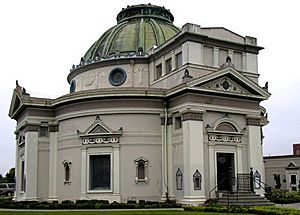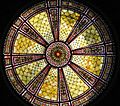- This page was last modified on 17 October 2025, at 10:18. Suggest an edit.
San Francisco Columbarium & Funeral Home facts for kids
 |
|
| Details | |
|---|---|
| Established | 1898 |
| Location | |
| Country | United States |
| Owned by | Dignity Memorial |
| No. of graves | ~8,500 niches |
| Designated: | 1996 |
| Reference #: | 209 |
The San Francisco Columbarium & Funeral Home is a special building in San Francisco, California. It's a place called a columbarium, where people's ashes are kept after they have passed away. This beautiful building is located near Golden Gate Park.
It was built in 1898 by an architect named Bernard J.S. Cahill. The Columbarium has a unique copper dome and shows off a style called Neo-Classical architecture. This means it looks like old Greek and Roman buildings. It's the only place in San Francisco where people of any religion can have their ashes kept, and it's open to everyone.
Contents
History of the Columbarium
How the Columbarium Began
The Columbarium was once part of a much larger area called the Odd Fellows Cemetery. This cemetery covered about 167 acres. The Columbarium was built to go along with a crematorium (a place where bodies are cremated) that was already there.
Changes in San Francisco Laws
In 1902, the city of San Francisco made a new rule. They decided that no more cemetery plots could be sold, and no new burials could happen inside the city. By 1910, even cremation was stopped within the city limits.
Because of these new rules, the Odd Fellows organization had to close their cemetery. They opened a new one called Green Lawn Cemetery in Colma. Starting in 1929, many bodies were moved from the old cemetery to the new one. Some families also chose to move the urns (containers for ashes) from the Columbarium.
What Happened to the Old Cemetery?
Most of the old cemetery buildings, like the crematorium and other mausoleums (large tomb buildings), were torn down. Many of the old gravestones were even used to build a seawall at Aquatic Park. Only the Columbarium was left standing.
Saving the Columbarium
After a while, the Columbarium was sold to different groups and started to fall apart. It wasn't being taken care of very well. But in 1980, a group called the Neptune Society of Northern California bought it. They started to fix it up and make it beautiful again.
One important person in this restoration was Emmitt Watson. He was hired as a painter but became the main person fixing up the building. Today, he often gives tours and shares the history of the Columbarium. In 1996, the building was officially recognized as a San Francisco Designated Landmark. This means it's an important historical place.
Design and Architecture
Inside the Columbarium
The Columbarium mixes different design styles, including baroque and neoclassical. The architect, Bernard J.S. Cahill, might have been inspired by a big event called the Columbian Exposition of 1893 in Chicago.
The building is quite large. From the entrance to the beautiful stained glass window on the other side, it's about 64 feet wide. The main round area inside is about 29 feet wide and reaches up to about 45 feet high.
Rooms and Niches
The ground floor of the Columbarium has eight rooms. These rooms are named after mythological winds. Six of these rooms have amazing stained glass windows. One window in the Aquilo room shows three angels flying. Some people think it was made by Louis Comfort Tiffany or John LaFarge, both famous artists.
The first floor rooms are named after constellations (groups of stars). The second and third floors have a simpler design. The Columbarium has many spaces called niches where urns are placed. The first floor has about 2,400 niches, the second floor has 2,500, and the third and fourth floors each have about 1,800. In total, there are more than 8,500 niches!
Famous People Remembered Here
The Columbarium is the resting place or has memorials for many important people from San Francisco's history, as well as some well-known figures:
- George Ainslie (1838–1913) – He was a representative for Idaho Territory in the U.S. Congress.
- John Backus (1928–2007) – A very important computer scientist who helped create the computer language Fortran. He won the Turing Award for his work.
- Chet Helms (1942–2005) – He helped organize music events and was a big part of San Francisco's "Summer of Love" in 1967.
- Frank E. Hill (1850–1906) – An officer in the U.S. Army who received the Medal of Honor.
- Harry August Jansen (1883–1955) – A professional magician known as Dante the Magician.
- Jerry Juhl (1938–2005) – A writer and puppeteer for the famous Muppets.
- Anna Elizabeth Klumpke (1856–1942) – A painter known for her everyday scenes. She was also a companion to a famous French animal painter, Rosa Bonheur.
- Dorothea Klumpke (1861–1942) – A talented Astronomer and mathematician. Two asteroids, 339 Dorothea and 1040 Klumpkea, were named after her!
- Domingo Marcucci (1827–1905) – Born in Venezuela, he was a "49er" during the California Gold Rush. He also built and owned ships in San Francisco.
- Harvey Milk (1930–1978) – An American politician who was the first openly gay man elected to public office in California.
- Jose Santana (1918–1997) – A violinist from Mexico who played with orchestras and mariachi bands. He was the father of the famous rock guitarist Carlos Santana.
- Edward Robeson Taylor (1838–1923) – He served as the 28th Mayor of San Francisco.




